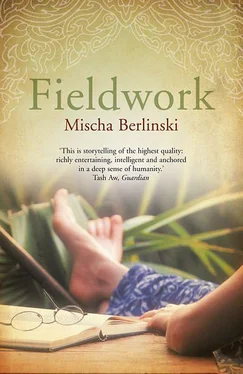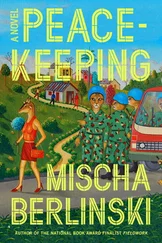She had a thousand questions. She didn't know why she had been moved into Farts-a-Lot's house and not some other. She didn't know what happened to the shaman when he entered his trance. She didn't really understand why the Vampire clans at the foot of the hill were poor; and she didn't really understand why it was so shameful for husband and wife to plant rice together in the rice fields. She had given Lai-Ma her running shoes, and it took almost a week to convince Lai-Ma that she hadn't meant to offend her. She didn't know why Lai-Ma had been offended. Most of all, she wanted to understand the dyal . She wanted to know why the Dyalo engaged in this complicated ritual to plant rice, and what they were thinking when they engaged in it. She thought that there were answers to all these questions, which literally kept her awake at night, but she didn't know them. She didn't even know what kind of answer would satisfy her. She only knew that for all of her hard work in Dan Loi, she hadn't yet grasped the Dyalo point of view, understood the Dyalo relation to life, or realized the Dyalo vision of the Dyalo world.
So that was the first thing that really bothered Martiya: all the time in Dan Loi, whenever things got tough, really tough, she had thought to herself that she was just the sharp end of the steel spear of scholarship, and that when she got back to Berkeley, all the other scholars and anthropologists and students of human behavior would help her understand the things she couldn't understand herself. Instead, Martiya found herself positively shunned in the department for having visited a preliterate society. The winds of anthropological fashion had shifted while Martiya was in the field, and preliterates were out: the hot young anthropologists were heading off to study South African diamond mines and Swedish ceramic factories and the corporate headquarters of AT&T. That's where the excitement was, and when Martiya tried to interest her colleagues in a rousing discussion of magical rites preceding the rice planting, she met with a palpable lack of interest. Instead, what they talked about in the graduate lounge and at the dinner parties and in the coffee shops were tenure and jobs and grants and absurd theories by trendy French philosophes . There was a time when nothing had thrilled her more than department gossip and the pitched battles between the various academic camps. Now, back from three years in Dan Loi, these debates bored her to death, and she could not make a connection between the generalities of theory and people like Lai-Ma, George Washington, and Farts-a-Lot.
One evening several months after coming back from the field, she went out on a date with another of her classmates. He was just finishing up his thesis, which dealt with the influence of the Catholic Church in a village in southern Mexico. She had read a draft of his thesis, which argued that the villagers had incorporated traditional magical practices into the Catholic liturgy. The facts that her classmate had assembled were fascinating, and reading the thesis, Martiya had been able to imagine the hot, dusty plain of Chiapas, the whitewashed adobe church, and the ecstatic peasants in tears carrying the cross through the village just as their forefathers many generations before had carried the icons of Aztec gods. But when Martiya asked her friend just what the natives felt as they carried the cross, it was clear from his stream of jargon and theory that he had no deeper insight than Martiya. She felt as if she were talking to a blind member of the Department of Art History, who could recount every detail of Caravaggio's life and describe every symbol in every painting, but who had never actually seen the canvases or felt the power of his art. The encounter left her increasingly sure that what she was looking for was at odds with what the Department of Anthropology could offer, at odds with what the discipline of anthropology could offer.
Martiya invited Karen for coffee, and the two women talked. It was an irony, Martiya said: eighty years after Bronislaw Malinowski told all the anthropologists to get off the veranda of the mission house and go and live with the natives, the only people in all the world who seemed to share Martiya's obsessive interest and fascination with the Dyalo were a family of missionaries huddled in Chiang Mai, waiting for the world to end.
Uh-huh , said Karen, who years later would feel extremely guilty about her response.
Karen spent a little more than two weeks in Dan Loi.
She followed Martiya's routine. In the early mornings, Martiya took Karen around the village, stopping in at one hut after another. This was how fieldwork ought to be done, Karen thought: patiently, over years. A little Dyalo village was a microcosm of the world, and every hut had its drama: in one hut, an old woman lay dying; in another, a young girl, frightened by the prospect of moving to her new husband's village, sobbed at her mother's side; and in a third, a husband teased his wife, the couple laughing. Karen had never seen this side of Martiya before, when in those dark huts that powerful, passionate personality diminished itself and a calm tenderness stole over her flashing eyes. It was inspiring , Karen said, all that intelligence and curiosity focused on this tiny village. Martiya still bubbled over with questions, even after all those years in the mountains.
One sleepy morning, Karen decided to lie in bed a little longer as Martiya went out about her rounds. Martiya's hut was not what Karen had expected. She had remembered Martiya's epistolary descriptions of dreary and primitive Dyalo huts, but on her return to Thailand, Martiya had built for herself a new house, simple but comfortable, two light and airy rooms under a high-arched ceiling. There was a bedroom, and now, in the early morning, Karen lay in bed and watched the sunlight filter in through square windows to fall in long white rectangles across the bamboo-tiled floor. The view extended out over the whole of the valley, light green mountains darkening in the distance, each bend in the mountains suggesting to Karen intrigue and mystery. For a few moments, Karen imagined staying with Martiya here in the mountains: getting someone to sell the Ford Pinto and wire her the money, not even bothering to resign her lectureship, just staying, building herself a hut, if not in this village then in the next one over.
When she was awake, Karen went into the other room of the hut, where Martiya kept her desk. This room, which Martiya called her study, stared out at the village itself. Long silk tai-lue tapestries, one red with blue, one yellow with green, one black with silver, hung along three walls; the other wall was dominated by a floor-to-ceiling bookcase. Martiya, Karen said, read voraciously, and every month her father sent her books from California. On Martiya's desk, there were three lilies in a glass bowl.
Karen was seized by a sudden desire to snoop, and she began to look through the volumes of hard-sided notebooks on the bookshelf. Martiya seemed to be writing a book. On the flyleaf of one of the notebooks was written a title, "The Dyalo Way of Life," and from what Karen could tell, the book was a memoir of daily life with the Dyalo. Karen thought of Colin Turnbull's famous memoir of life with the Pygmies, The Forest People . Karen read Martiya's memoir all through the morning, and when she was finished, she was convinced that the completed manuscript, still only a fragment, would be one of those rare literary documents that created for the reader the life of a whole people. She had spent several days now in a Dyalo village, but nothing that she had seen made the Dyalo come alive like Martiya's account. Hearing Martiya's footsteps on the terrace, Karen returned the notebook to its proper place and went with her friend to make lunch in the cooking hut.
Читать дальше












